NRGLite
0
- Joined
- Aug 6, 2014
- Messages
- 167
- Points
- 18
EDIT: Decided not to add that much pics. Enjoy the post!
As the wavelength of 445 nm lasers are close to UV, fluorescent materials glow with an unearthly light once they are shone upon. Of course 405 violet lasers fairly brush the ultraviolet range, so if anyone could show some pics of violet lasers affecting things that would be awesome :wave:!
The following is a picture of my brother's Lego minifigure with some fluorescent blocks under light:

Now the same model is shown in darkness under the glow of my 1W laser diffused at the ceiling:

Notice how in this blurry image the greenish glow of the Legos shine out so conspicuously. Bringing a finger close to a glowing orb produces a faint hue of green upon one's finger; proving that it really does glow. Bringing the beam close causes it to fairly shine.
A random photo is next showing a few fluorescent pieces of Lego. There is an orange fluorescent block in the foreground and a phosphorescent skull in the background. The orange block does not fluoresce as dramatically as the green ones, most likely because we cannot see red-orange as well as we see green. The skull is not charged.

The next is a video about the effects of 445 nm lasers upon certain materials. Unlike what the camera caught, the reflection of the laser as it hit the floor is really a lighter shade of blue. This is due to the fact that certain ultraviolet sensitive paint or varnish was used upon the floor, causing it to reflect a different shade of blue. A phosphorescent star is also in the background.
http://laserpointerforums.com/attachment.php?attachmentid=45917&stc=1&d=1408481463
Phosphorescence
As seen in the video above, the star is charged by the heavily diffused laser. Different wavelengths farther away from the ultraviolet range will render the phosphorescent material harder and harder to charge, to the point that green and red lasers cannot have an effect upon the material at all. The following is a video of three phosphorescent Lego minifigures being charged. In real life, the figures do not suddenly brighten up; it is the camera's effect.
http://laserpointerforums.com/attachment.php?attachmentid=45918&stc=1&d=1408481608
More videos coming soon!
MORE STUFF
As some have said that 445 nm lasers do not fluoresce, here are a few pictures:

That is done on tile. No fluorescence is shown.

This one, however, shows a lighter blue upon the wooden floor. The pictures do not give it justice: It's like owning a 473.
And a picture of the dot; because why not!

Hope you enjoyed that!
As the wavelength of 445 nm lasers are close to UV, fluorescent materials glow with an unearthly light once they are shone upon. Of course 405 violet lasers fairly brush the ultraviolet range, so if anyone could show some pics of violet lasers affecting things that would be awesome :wave:!
The following is a picture of my brother's Lego minifigure with some fluorescent blocks under light:
Now the same model is shown in darkness under the glow of my 1W laser diffused at the ceiling:
Notice how in this blurry image the greenish glow of the Legos shine out so conspicuously. Bringing a finger close to a glowing orb produces a faint hue of green upon one's finger; proving that it really does glow. Bringing the beam close causes it to fairly shine.
A random photo is next showing a few fluorescent pieces of Lego. There is an orange fluorescent block in the foreground and a phosphorescent skull in the background. The orange block does not fluoresce as dramatically as the green ones, most likely because we cannot see red-orange as well as we see green. The skull is not charged.
The next is a video about the effects of 445 nm lasers upon certain materials. Unlike what the camera caught, the reflection of the laser as it hit the floor is really a lighter shade of blue. This is due to the fact that certain ultraviolet sensitive paint or varnish was used upon the floor, causing it to reflect a different shade of blue. A phosphorescent star is also in the background.
http://laserpointerforums.com/attachment.php?attachmentid=45917&stc=1&d=1408481463
Phosphorescence
As seen in the video above, the star is charged by the heavily diffused laser. Different wavelengths farther away from the ultraviolet range will render the phosphorescent material harder and harder to charge, to the point that green and red lasers cannot have an effect upon the material at all. The following is a video of three phosphorescent Lego minifigures being charged. In real life, the figures do not suddenly brighten up; it is the camera's effect.
http://laserpointerforums.com/attachment.php?attachmentid=45918&stc=1&d=1408481608
More videos coming soon!
MORE STUFF
As some have said that 445 nm lasers do not fluoresce, here are a few pictures:
That is done on tile. No fluorescence is shown.
This one, however, shows a lighter blue upon the wooden floor. The pictures do not give it justice: It's like owning a 473.
And a picture of the dot; because why not!
Hope you enjoyed that!
Attachments
-
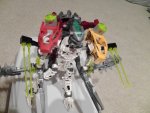 S1540001.JPG70 KB · Views: 384
S1540001.JPG70 KB · Views: 384 -
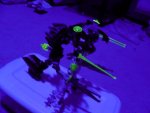 S1540002.JPG54.6 KB · Views: 412
S1540002.JPG54.6 KB · Views: 412 -
00071 (convert-video-online.com).avi9.5 MB · Views: 58
-
00070 (convert-video-online.com).avi6.1 MB · Views: 54
-
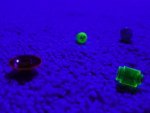 S1540003.JPG48 KB · Views: 448
S1540003.JPG48 KB · Views: 448 -
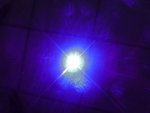 S1550004.jpg37.5 KB · Views: 284
S1550004.jpg37.5 KB · Views: 284 -
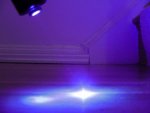 S1550005.jpg41.5 KB · Views: 313
S1550005.jpg41.5 KB · Views: 313 -
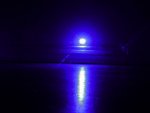 S1550006.jpg28.4 KB · Views: 305
S1550006.jpg28.4 KB · Views: 305
Last edited:





